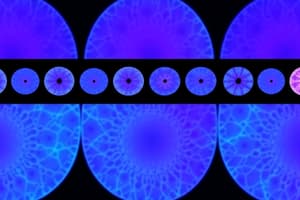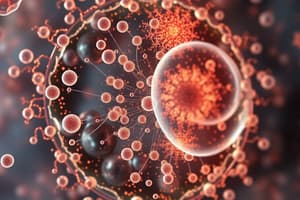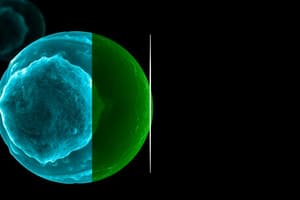Podcast
Questions and Answers
What is the DNA amount in a cell at G2 phase compared to the original diploid amount?
What is the DNA amount in a cell at G2 phase compared to the original diploid amount?
- It remains at 2C.
- It decreases to 1C.
- It is doubled to 4C. (correct)
- It varies but averages at 3C.
During which phase does the synthesis of histone proteins occur?
During which phase does the synthesis of histone proteins occur?
- M Phase
- S Phase (correct)
- G1 Phase
- G2 Phase
What role do cyclins play in the cell cycle?
What role do cyclins play in the cell cycle?
- They activate kinases for cell cycle regulation. (correct)
- They decrease DNA replication.
- They facilitate RNA transcription.
- They inhibit mitosis.
Which phase is characterized as the 'invisible phase' of the cell cycle?
Which phase is characterized as the 'invisible phase' of the cell cycle?
What is the main activity that occurs during the G2 phase?
What is the main activity that occurs during the G2 phase?
What happens to S-cyclin after its function is fulfilled?
What happens to S-cyclin after its function is fulfilled?
What is the average duration of the entire cell cycle in a human cell?
What is the average duration of the entire cell cycle in a human cell?
What are the key processes involved in the M phase of the cell cycle?
What are the key processes involved in the M phase of the cell cycle?
What is the longest stage of karyokinesis?
What is the longest stage of karyokinesis?
During which stage does the nuclear envelope completely disintegrate?
During which stage does the nuclear envelope completely disintegrate?
What is the role of spindle fibers during metaphase?
What is the role of spindle fibers during metaphase?
Which phase of karyokinesis has chromosomal fibers and supporting fibers arranged in the cell?
Which phase of karyokinesis has chromosomal fibers and supporting fibers arranged in the cell?
What happens to the chromatids during anaphase?
What happens to the chromatids during anaphase?
Which of the following statements is true about prophase?
Which of the following statements is true about prophase?
What feature is common at the metaphase stage?
What feature is common at the metaphase stage?
What is the smallest stage of karyokinesis?
What is the smallest stage of karyokinesis?
What occurs when a cell's surface area becomes insufficient to draw necessary materials?
What occurs when a cell's surface area becomes insufficient to draw necessary materials?
Which factor is NOT responsible for cell division to occur?
Which factor is NOT responsible for cell division to occur?
What is the term used for mitosis in plant cells?
What is the term used for mitosis in plant cells?
What do mitogens do?
What do mitogens do?
During which phase does karyokinesis occur?
During which phase does karyokinesis occur?
What is the characteristic of amphiastral division in animal cells?
What is the characteristic of amphiastral division in animal cells?
What is Eumitosis?
What is Eumitosis?
What does cytokinesis refer to?
What does cytokinesis refer to?
What are darkly stained bead-like structures called that appear along the chromatin fibre?
What are darkly stained bead-like structures called that appear along the chromatin fibre?
What is the term for the phase characterized by the absence of visible chromosomes during division?
What is the term for the phase characterized by the absence of visible chromosomes during division?
Which option best describes the process of amitosis?
Which option best describes the process of amitosis?
How many mitotic divisions are needed to form 'n' cells?
How many mitotic divisions are needed to form 'n' cells?
From the formula x = 2n, what does 'x' represent?
From the formula x = 2n, what does 'x' represent?
What characterizes the intrameiotic interphase?
What characterizes the intrameiotic interphase?
What type of organisms primarily utilize amitosis for cell division?
What type of organisms primarily utilize amitosis for cell division?
What is a characteristic of a bivalent in meiosis?
What is a characteristic of a bivalent in meiosis?
What is the primary purpose of cell division in unicellular organisms?
What is the primary purpose of cell division in unicellular organisms?
Which method of cell division is responsible for producing gametes?
Which method of cell division is responsible for producing gametes?
In multicellular organisms, what is a key function of cell division?
In multicellular organisms, what is a key function of cell division?
Which of the following processes occurs during the cell cycle before cell division takes place?
Which of the following processes occurs during the cell cycle before cell division takes place?
How do multicellular organisms benefit from cell division?
How do multicellular organisms benefit from cell division?
Which option correctly describes amitosis?
Which option correctly describes amitosis?
What is one key difference between mitosis and meiosis?
What is one key difference between mitosis and meiosis?
What occurs during the cell cycle before a cell is ready to divide?
What occurs during the cell cycle before a cell is ready to divide?
Flashcards are hidden until you start studying
Study Notes
Introduction to Cell Cycle and Cell Division
- Cells serve as the basic unit and functioning component of all organisms, including both unicellular and multicellular types.
- Cell division is essential for life, contributing to growth, repair, maintenance, and reproduction.
- The process of cell division includes multiple methods: Mitosis, Meiosis, and Amitosis.
- Unicellular organisms rely on cell division for population growth, while multicellular organisms depend on it for development and physiological functions.
Objectives of the Chapter
- Understand and write about the various phases of the cell cycle.
- Learn to sequence the phases of cell division correctly.
- Distinguish the differences between mitosis and meiosis.
Cell Cycle Phases
- G1 Phase: Initial phase with 2C DNA and 2n chromosomes. DNA replication preparation occurs here.
- S Phase: DNA is replicated to 4C. Centrioles double, histones are synthesized, and chromosomes remain invisible until division.
- G2 Phase: Pre-mitotic phase where organelles duplicate, RNA transcription, protein translation, and spindle preparations occur. Cyclin-dependent kinases (Cdks) regulate cell progression.
M-Phase (Mitosis)
- Defined by the actual division of the cell, including both karyokinesis (nuclear division) and cytokinesis (cytoplasmic division).
- The human cell cycle averages 24 hours, with M-phase lasting about one hour.
Surface-Volume Ratio
- As a cell grows, its volume increases more significantly than its surface area, leading to a stage where surface area becomes insufficient for material exchange.
- Critical surface-area-to-volume ratio prompts cell division to maintain efficiency.
Mitosis Phases
- Interphase: Preparing phase for cell division.
- Factors influencing cell division include:
- Surface area-to-volume ratio
- Karyoplasmic index
- Mitogens: Substances that induce mitosis, such as auxin and gibberellin.
- Distinction between animal and plant mitosis: Animal cells exhibit amphiastral division, while plant cells undergo anastral division without centrioles.
Karyokinesis Stages
- Prophase: Chromatin condenses into chromosomes; centrioles align at poles; spindle apparatus forms.
- Metaphase: Nuclear envelope disassembles; spindle fibers bind to kinetochores; chromosomes align on the metaphase plate.
- Anaphase: Centromeres split, and sister chromatids are pulled apart toward opposite poles.
Amitosis
- A primitive form of cell division without visible chromosomes or spindle formation.
- Involves simultaneous division of the cytoplasm and nucleus via constriction.
- Typically faster than other division methods, completing in 20 to 30 minutes, and occurs in prokaryotes and some eukaryotes like budding yeast.
Key Formulas Related to Cell Division
- For ‘n’ cells, mitotic divisions required are n-1.
- To produce ‘x’ cells, the number of generations (n) equals x = 2^n.
- ‘n’ meiosis events generate ‘n’ seeds or fruits.
Studying That Suits You
Use AI to generate personalized quizzes and flashcards to suit your learning preferences.




